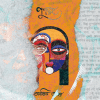Kazi Nazrul Islam and “World Literature”: Some Questions and Concerns

I think it might prove useful to have at least a quick idea of Nazrul's range of readings and his languages. One who had no formal education after class 10, Nazrul knew—in addition to his native Bangla—as many as six languages: English, Arabic, Persian, Urdu, Hindi, and Sanskrit.w
Kazi Nazrul Islam (1899-1976) has been customarily characterized as a rebel poet, particularly, if not exclusively, because of his 1922 poem called "Bidrohi" (the Rebel)—a poem that fiercely stages his political, linguistic, even metrical rebellion all at once. But, in his subsequent works, Nazrul emerges as more than a rebel poet as such. In fact, he is a revolutionary by his own, even repeated admissions. And the famous triad of the Turkish Revolution, the Irish Revolution, and, above all, the Russian Revolution variously inspired, informed, and inflected Nazrul's work. Regarded as one of the greatest Bangla poets, Nazrul was also a musician, short story writer, novelist, playwright, essayist, editor, journalist, drummer, film-maker, actor, political activist. And he was even a creative "theorist" in his own right—one who offers intriguing, even provocative, formulations and crucial conceptual coordinates concerning different figures in what has come to be known as "world literature."
Indeed, contemporary Nazrul criticism—while identifying him as a "versatile genius"—has not paid much attention to his creative engagement with some global literary figures, exemplified as it is in his quite-ignored essay called "Bartoman Bishshya Shahittyo" (Contemporary World Literature), published in 1939. I myself wrote—more than once— about different aspects of Nazrul's work for this page, underlining his staggering range while also emphasizing the need for engaging his essay on world literature. But I could not dwell on Nazrul's ideas and concerns broached in that essay. In this very short piece, then, I intend to touch upon a few crucial dimensions of that work in order to make a start on an extended discussion in the future.
I think it might prove useful to have at least a quick idea of Nazrul's range of readings and his languages. One who had no formal education after class 10, Nazrul knew—in addition to his native Bangla—as many as six languages: English, Arabic, Persian, Urdu, Hindi, and Sanskrit. He even wrote "bhajans" in Hindi and "ghazals" in Urdu, marking new moments of multi-lingual creative interventions in colonial Bengal. And, of course, Nazrul translated exemplarily from Urdu, Hindi, Persian, and Arabic, remaining arguably the best translators of such great Persian poets as Hafiz and Omar Khayyam while his translations of as many as 38 suras from the Quran are nothing short of exceptional.
Nazrul read widely on literary, cultural, and religious texts across the world. And some of his favorites include the ancient Indian epics such as the Ramayana and the Mahabharata while religious texts such as the Quran and Hadith, the Bible, and the Gita attracted him early on in his life. Then, for him, there was quite a constellation of literary figures from the Middle-East: Imrul Qayes, Sheikh Saadi, Omar Khayyam, Hafiz, Jami, Rumi, among others. As for the ones within South Asia, one can readily mention Kalidasa, Kabir, Nanak, Chaitanya, Tukaram, Chandidas, and Lalon, among numerous others. It's telling that the center of Nazrul's literary internationalism was by no means Europe—unlike the Eurocentric metropolitanism of his contemporaries known as the modernists of the 1930s—but, then, Nazrul was certainly interested in the works of Shakespeare, Milton, the English Romantics, Whitman, especially in some Russian writers, and in even some contemporary Polish and Norwegian writers.

Now, in his essay on world literature, Nazrul does not immediately deal with the conceptual incoherence of what has come to be known as "world literature" as such—a nebulous term that continues to be rethought today. But Nazrul—as a revolutionary—is quick to politicize the notion of "world literature" by noting polarities and mobilizing certain interpretive metaphors while calling attention to both converging and conflictual constellations and configurations of creative writers across linguistic and geographical borders and boundaries. For instance, he begins his essay by deploying the metaphors of "earth" and "heaven" to identify certain conflictual trends and tendencies in literature, and thus maintains that there are those writers who are earth-bound, rooted, in love with the mother-earth; while, according to him, there are also those who wing heavenward—Nazrul alludes to P.B. Shelley's "skylark" and John Milton's "birds of paradise" to characterize those writers—ones who are primarily dreamers, who even aim at some kind of idealist transcendence.
But Nazrul—well before such revolutionary Latin American poets as Ernesto Cardenal and Roque Dalton—also ranges beyond any easy binarism between "earth" and "heaven" to encompass a third space inhabited by those writers who believe in "the realization of Paradise on earth." In any event, while talking about world literature—one which Nazrul reads not as an established canon of European masterpieces but "as a mode of circulation and reading," to use David Damrosch's formulation from his book What is World Literature? (2003)—Nazrul is among the first ones in colonial Bengal to suggest, at least implicitly, that the literary itself constitutes a loaded site of ideological battles and even class struggles in history, although Nazrul remains opposed to the instrumentalization of the literary as such while remaining attentive to the dialectical interplay between the aesthetic and the political.
And it is both interesting and instructive that in his essay, Nazrul brings together—among others—Rabindranath Tagore and W.B. Yeats on the one hand, and Maxim Gorky and Bernard Shaw on the other, to suggest certain conflicts and polarities predicated on both aesthetic and ideological orientations. But, in his essay, Nazrul speaks of not only resistance, rebellion, and rupture, but also what he himself calls "rokto-makha revolution" (blood-drenched revolution), as he deliberately pits the aestheticism of John Keats against the hard, modern materialism of Walt Whitman, suggesting thereby that the revolutionary move resides, among other things, in making the great ideas deeply material and pervasively sensuous across the world. Then Nazrul pays a short tribute to one of his most favorite poets—Alexander Pushkin—while he even enthusiastically mentions the great Russian novelist Fyodor Dostoevsky, quoting from chapter IV of part IV of his novel called Crime and Punishment: "I bow down not to thee but to suffering humanity in you."
It is by no means pointless that Nazrul admires both Dostoevsky and Maxim Gorky—one whose work Nazrul ardently compares to tidal waves—making the point indirectly that contraries and contradictions within the domain of the literary are to be dialectically engaged to advance a revolutionary cause, while he also accentuates—in the Marxist tradition, so to speak—the need for reading Honoré de Balzac and Emily Zola by way of quoting the French writer Anatole France, for instance. Towards the end of his essay, Nazrul even calls attention to the Italian writer Grazia Deledda and the Polish writer Wladyslaw Reymont to suggest how the insignificant and the quotidian—having to do with the simple peasant lives—matter in so-called world literature. In other words, for Nazrul, what is called "world literature"—as a mode of reading—cannot remain divorced from the materiality of a cause he envisages as a poet who is also a revolutionary.
Azfar Hussain will be teaching as Summer Distinguished Professor of English and Humanities at the University of Liberal Arts-Bangladesh (ULAB). He teaches Integrative/Interdisciplinary Studies at Grand Valley State University in Michigan, and is Vice-President of the Global Center for Advanced Studies, USA.

 For all latest news, follow The Daily Star's Google News channel.
For all latest news, follow The Daily Star's Google News channel. 








Comments